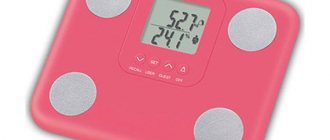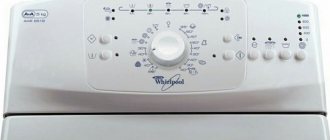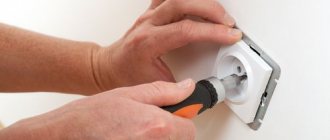Types of scales
Modern household scales come in two types: mechanical and electronic. Mechanical ones have an analog dial, often small, with a division value of 1 kg. Accordingly, the accuracy they provide when weighing is +/- 0.5 kg. For most people who just want to know approximately their weight, this option is suitable. However, for athletes, as well as in medicine, such accuracy is not enough. Electronic scales provide results with an accuracy of up to 100 grams (there are models that show every 10 g). The value is displayed on the screen. Advanced models of scales have additional functions, for example, a built-in calculator/body analyzer, which allows you to calculate the proportions of the body by component composition directly during weighing.
Electronic scales with body composition analyzer
Structurally, electronic scales consist of some kind of sensor and a system for displaying the result. Simple inexpensive copies have a spring sensor, the data from which is digitized and shown on the display. Newer models have a strain converter. Such devices have maximum accuracy, as they are completely electronic. Most often, they have built-in intelligent systems that allow one to determine additional information about the state of the body.
The most reliable electronic scales
Picooc Mini WH scales on Yandex Market
Scales Tanita BC-730 RD on Yandex Market
Picooc S3 Lite scales on Yandex Market
There are electronic scales for measuring your own weight in almost every home - people try to monitor changes in their figure as much as possible in order to take timely measures. To do this, they weigh themselves daily, but the values on the scales may be different each time. In fact, this can be explained by physical changes - the normal functioning of the body. But when a person stands on the platform several times in a row and receives different values, this should raise red flags. Next, we will take a closer look at why electronic floor scales often show different weights.
Why electronic scales can “lie”
It happens that several weighings performed in a row have different results. This problem occurs frequently and frustrates users. The reasons for this lie in improper operation of the equipment and even in small nuances in the weighing process.
The main reasons are discussed below.
- The scale must stand on a perfectly level floor. Any unevenness makes the sensor work incorrectly. In this situation, you need to place the scales in another, more suitable place.
- You also need to step on the scales correctly: straight, without pressing or skewing on one side. The feet should be placed parallel to each other, at the same level. It is advisable to stand on the platform at each weigh-in with your feet equally positioned and your weight evenly distributed.
Correct placement of feet on scales
- The legs should be on the platform with the entire surface of the foot. The body is at right angles to the horizontal. Point pressure with your heels and/or toes can significantly distort the result.
- Electronic scales work using sensitive sensors. Negative environmental influences, such as severe changes in room temperature, can affect the accuracy of measurements.
- It has been noticed that near heating devices, scales can also show a result that differs from the real one.
- It is important to properly care for electronic scales. In particular, washing them with aggressive detergents is strictly prohibited. Chemicals can negatively affect sensors and electronics that convert measurement information. Glass scales are best suited for everyday use: they are quite accurate and easy to care for.
Glass scales are easier to care for
Any electronics requires careful use. Libra is no exception. To avoid problems and make measurements as accurate as possible, you should study the user manual.
How to fix the problem
What to do: electronic scales do not show weight correctly? If none of the above reasons apply, then they may be broken. The malfunction may be as follows:
- The batteries have expired.
- The connecting cable comes off - this is the element connecting the electronic board and the display; if it malfunctions, it will distort the data. The board should be pressed closer to the display.
- The relay is faulty, for example, the contacts have become thin.
- The mechanism is damaged due to exceeding the permissible weight or incorrect use of the device.
- Incorrect calibration also leads to data corruption.
Why do electronic scales show different weights? New models must be calibrated in production. Many models provide automatic calibration. However, the measurement accuracy may be compromised if you stand on them several times in a row or move them frequently.
In this case, you can perform calibration yourself. Methods for calibrating scales can be found in the instructions for the device, and this does not require any special skills.
Electronic scales show different weights, despite the fact that they are in good condition and do not need cleaning or calibration? Then follow the following recommendations when taking measurements:
- It is necessary to place the scales only on a flat, hard surface, and always take measurements in the same place.
- It is important to stand on the device correctly during measurement. The feet should be placed parallel to each other. They should not move to the edges or hang off the surface of the scale. You must stand straight and calm. Do not lean against a wall or other furniture.
- All nutritionists recommend weighing yourself in the morning on an empty stomach, without shoes and in a minimal amount of clothing. Weight can change upward over the course of a day due to the amount of food eaten and fluids drunk.
Possible breakdowns of electronic scales
If the floor scales are used correctly, but the result is different each time, they are most likely broken. You can carry out a preliminary diagnosis of the malfunction using the following symptoms.
- The scales do not turn on and no information is displayed on the screen at all. This may indicate that the device is not powered, that is, its power supply (battery) is dead. To solve the problem, it is enough to replace the batteries with new ones. In advanced models, a dead battery produces a specific error code.
Replacing the battery in the scales
- Loss of contact between the scale cable on one side. This element connects the electronic unit and the visualization unit (display). If the cable has moved away from one of the elements, the scale may show strange symbols or nothing at all. You can solve the problem by removing the protective cover and inserting/pressing the board more tightly to the display.
- It happens that the scales show an unexpected result. For example, an adult weighs 15 kg, or weighs 30 kg more than yesterday, without changing in appearance. Most often, it is a matter of wear of the contact elements. In this case, the relay must be replaced.
- The appearance of gaps not provided for by the design leads to damage to the scales. This happens if the device sits on the floor all the time and is not put away in its packaging or cleaned regularly. In this case, the scale must be disassembled and all components carefully cleaned with a soft brush.
- Another reason why scales can “lie” is incorrect calibration of the device. Some models do it automatically when installed on the surface and turned on, others must be configured manually. How to do this can be found in the user manual for a specific device.
Scale calibration
Why electronic scales show different weights: deception everywhere
Let's tell you why the computer does not see the ereader when connected via USB...
Beloved readers of World of Access!
We are grateful to you for every ruble that you send to the development of our startup! All money goes to reward the authors, pay for proofreading services and pay for hosting. We want to continue to please you! Thanks to you, our project continues to remain independent and useful. We would never have been able to do this without your donations. Thank you and low regards! Sincerely, Editor-in-chief Mir Access
It is most often simple to answer why electronic scales show different weights. In what cases do electronic scales show different weights?
Recently, electronic floor scales have become very popular - almost every family that monitors their health has them. If you measure your body weight daily, you can track unwanted weight fluctuations and take the necessary measures in time
Experts recommend weighing yourself at the same time of day - this approach makes it possible to determine exact changes in weight.
If you weigh yourself at different times of the day, you may notice slight deviations up or down. So in the morning a person is always a little lighter than in the evening - this is a normal phenomenon, as it is associated with the physiological processes of the body. But if you step on the scale several times in a row and the scale readings are completely different, this is a reason to think about the correctness of the measurement.
Before answering why electronic scales show different weights, it is necessary to note that there are two types of scales for determining body weight: electronic and mechanical. It is mechanical type scales that give the biggest error.
Especially for you: iPhone shows apple and does not turn on: what to do
The error of mechanical scales can vary within 1 kilogram - manufacturers always warn about this in the device’s operating instructions. Electronic scales have a measurement principle similar to mechanical scales. Electronic scales are considered the most accurate - they measure down to grams
On mechanical scales, due to the specific markings, it can be difficult to determine the exact number of grams - this leads to a decrease in accuracy within 500 grams. In cheap and simple models of scales, the weighing results depend on the operation of the built-in measuring spring.
Improved models have a voltage sensor - as soon as a person steps on the scale, the sensor tightens and causes an electrical signal, which is displayed on the display in the form of numbers or other information
Today, our lives also include smart scales that can show the content of fat, muscle tissue, and water in the body.
Possible malfunctions of electronic scales
When the electronics of the scales constantly show different results, the reason for this may be a breakdown of the device. There are several types of failures of electronic scales.
The answer to why electronic scales show different weights may be the battery - the batteries of the scales must be changed regularly, since this device is sensitive to power.
The reason for inaccurate measurements of electronic scales may be due to dead batteries, especially if the device display does not display data or the numbers look strange.
The electronic scale cable is damaged
If the cable is faulty, they will not show accurate data. This cable connects the board and the device display. If the cable connector does not fit tightly, the scale readings may not be displayed at all or may have inaccuracies. You can fix the problem as follows: slightly lift the board and press it firmly against the scale display.
Especially for you: Samsung A7 or Honor 8X which is better: find out who is stronger
Thinning or tearing of the contact ends of the device
In case of thinning, rupture or other damage to the contact cables, electronic scales may also show different weights. Sometimes the discrepancies can be significant - from 1 to 10 kilograms. In this case, it is necessary to replace the device relay and the question of why electronic scales show different weights will be resolved.
Water getting inside the scale
When water or small debris gets inside the scales, measurements may become less accurate, especially since electronic scales are almost always on the floor. In cases of water damage, the scale display may not show anything at all. It is necessary to disassemble the scales and carefully clean the internal structure of the scales from dust and debris.
Incorrect scale calibration
It is necessary to read the instructions for electronic scales so that they show an accurate measurement. Some scales can be adjusted independently by simply placing them on the floor. Some electronic scales can only be set up and calibrated manually.
Malfunctions in the electronics of the scales
Errors in electronic scales can occur due to incorrect operation of the device or shocks. The most common problem with electronic scales is that when weighing, they show completely different results.
Improper use of the device can lead to errors and inaccuracies when measuring weight. Before starting operation, you must carefully read the instructions for the electronic scales.
What to consider when weighing on electronic scales
Level and stable base - if the scales are placed on an uneven surface and are wobbly, you should move them to a flat surface. The problem of why electronic scales show different weights is most often solved in this way.
It is important to stand on the scale correctly - your legs and feet should be level - your feet should be parallel, and you should stand in the same place when weighing. You must stand level on the scales; you must not tilt your body or shift the center of gravity. If you stand on your heels, the scale will show less weight, and if you rise on your toes, the weight will be greater.
The temperature of the room where the scales are located must be constant. If there are sudden changes in temperature or humidity, the scales may fail or show incorrect results.
Especially for you: What is affected by the processor frequency in a smartphone: an explanation for dummies
Do not store electronic scales near a central heating radiator or electric heating devices.
It is not recommended to wash the scales under running water or clean them with chemicals. It is worth remembering that you need to treat electronic devices with extreme care and precision, carefully read the operating instructions, and then the problem of why electronic scales show different weights will not affect you.
Is something broken or not working? Tell us about your problem with your TV, smartphone, application or other device and we will solve it - write your question in the comments to this article, or by email [email protected] - we will definitely answer your question and solve it within one weeks. We will soon be holding a blitz with unusual prizes for our regular readers - keep an eye on the site every day.
Did you like the article? Support our IT magazine in any convenient way! For now, we are relying on pure enthusiasm, but we do not do custom reviews 
Selection Guide
In order to avoid problems with purchased scales in the future, you should listen to the opinions of experts who recommend paying attention to the following points when purchasing.
- If you come across a model with a choice of units of measurement, make sure that kilograms are present in the table.
- For use in the bathroom, you should buy a model with moisture protection.
- For comfortable use, choose floor scales with a rough surface rather than a smooth one.
- When choosing a material, it is better to trust metal models rather than plastic ones.
- Don't skimp on your purchase. Cheap models don't last long, the weight they display isn't always accurate, and you'll end up overpaying for repairs or buying a new scale.
- Be sure to check the measurement accuracy before purchasing.
- When working with scales on a carpet, the calculation error can be up to 10%.
- Do not use models that are not designed for your weight.
- Magnetic radiation from instruments located in the room can affect the quality of weighing, so make sure that the scales are located away from radio equipment.
- When purchasing electronic models, choose a model with 4 sensors. This information is not always indicated on the price tag, so you will have to look at the device’s passport.
- The more built-in functions a device has, the greater the error in their calculations. Try to choose simple and reliable models.
Do not forget that electronic scales operate on batteries, which need to be changed at least once every 6 months.
Rules for care and use
For correct operation, it is important not only to choose and use the device correctly, but also to properly care for it. By following a few tips for maintaining your instrument, you will achieve longer life and more accurate weighing:
- Electronic scales are known to be extremely sensitive. Therefore, you should avoid sudden changes in temperature, large amounts of moisture, sudden lowering or shaking, exposure to dirt and direct sunlight.
- Do not place the scale near heating devices.
- It is not recommended to use chemicals to clean the device.
- Avoid contact of various liquids with the surface of the measuring unit.
Rules for using electronic scales
To ensure that electric scales last a long time, you must not:
- Expose them to temperature changes;
- Wash them under running water;
- Shake or drop sharply;
- Place the device in direct sunlight;
- Bring the scales to heating (heating) devices;
- Use chemicals for cleaning.
Important! If you have ruled out all the problems outlined in the article, then most likely the scale needs repairs, and it needs a repairman!
Source: setafi.com











